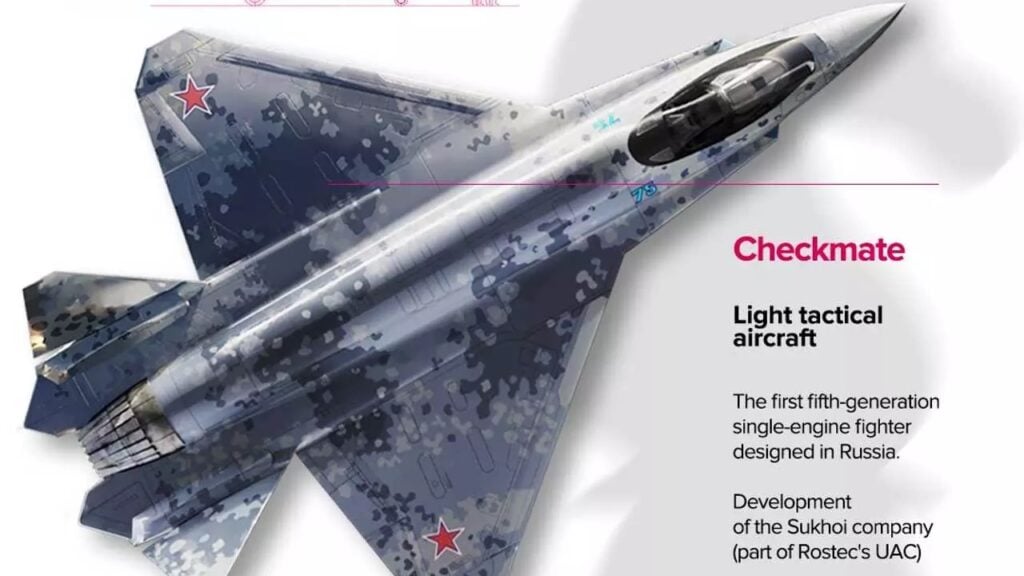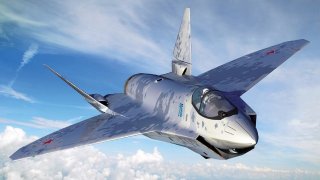Su-75 Checkmate: Russia's 'Cheap' F-35 Looks Like a Hot Mess
Russia's advanced military systems, like the T-14 Armata tank and Su-57 fighter jet, have largely been absent from the Ukraine War, with older, less advanced systems dominating the battlefield. The Su-75 "Checkmate," a fifth-generation fighter intended for export, faces significant development challenges, including Western sanctions that complicate its production.
Summary and Key Points: Russia's advanced military systems, like the T-14 Armata tank and Su-57 fighter jet, have largely been absent from the Ukraine War, with older, less advanced systems dominating the battlefield. The Su-75 "Checkmate," a fifth-generation fighter intended for export, faces significant development challenges, including Western sanctions that complicate its production.

While Russia's defense industrial base outpaces those of the U.S. and Europe in some areas, its advanced systems struggle, casting doubt on their reliability and export potential.
With Russia poised to win the war of attrition against Ukraine, let it not be said that the bulk of Russia’s next-generation systems are the reason. The vaunted Russian T-14 Armata main battle tank, which many analysts believed was the most advanced MBT in the world, was kept out of the brutal war that Vladimir Putin has described as “existential.”
Meanwhile, the Su-57, already low in numbers before the war began and relatively untested in combat, was kept away from the contested skies over Ukraine. Instead, Moscow opted to deploy older systems intended to simply overwhelm the enemy.
That is precisely what has happened. Russia’s defense industrial base today outstrips the antiquated and sclerotic industrial bases in Europe, the United States, and Canada.
Russia Struggling to Keep Up with Advanced Systems
But the one area where Moscow is struggling is with its higher-end systems – not only the Su-57 or the T-14 Armata, but the much-ballyhooed Russian Su-75 “Checkmate.” This single-engine, fifth-generation warplane designed by the Sukhoi Design Bureau for the Russian Aerospace Forces as well as for export has had a rough go lately. It was unveiled by Sukhoi at the MAKS 2021 airshow in Russia and it was intended to serve as a more cost-effective alternative to the Su-57 (hence its focus on export markets).
Put another way, if the Su-57 was Russia’s answer to America’s F-22 Raptor or China’s Chengdu J-20 “Mighty Dragon,” then the Su-75 was Russia’s answer to America’s F-35 Lightning II or the Shenyang FC-31.
As of now, the Su-75 is still in its development stage, and there are no production models in existence. The project has faced challenges, including the impact of the Western sanctions on Russia.

While Russia has brushed off some of the most damaging impacts of the Western sanctions, some of their military programs remain negatively harmed. That’s because the more export-friendly systems purposely incorporate Western technology to make them easier to sell.
That’s great in peacetime. In war, however, since the Su-75 is built with Western systems, it presents complications.
Some Facts About the Checkmate
The Su-75 is designed to fly at a range of 3,000 kilometers (1,864 miles). This warbird supposedly carries a payload of up to 7,400 kilograms (16,314 lbs), and can reach speeds as fast as Mach 1.8 (1,381 miles per hour) to Mach 2.0. The Su-75 Checkmate features stealth characteristics, including reduced radar signature, and is expected to have advanced avionics and weapons systems.
As for its status as a serious challenge to NATO warplanes, it’s difficult to make a definitive assessment at this stage. The complications to the production side of this bird have incensed some Russian defense leaders, as this was supposed to be a product that was widely exported. And since the start of the Ukraine War, Russia’s weapons export market has taken a serious hit, as Western nations have demanded the rest of the world pick a side.
What’s more, many countries have doubted the reliability of Russian advanced weapons platforms in the wake of the Ukraine War, because so many of the advanced Russian systems have been sidelined by Moscow. In the eyes of these third-party countries, if the Russians are reticent to use their advanced systems in their own war, why would these third-party nations want to splurge limited funds and resources on the Su-75?
What Will Become of the Su-75 Checkmate?
Sukhoi continues to promote this warbird as an alternative to the American F-35. It remains a point of interest among prospective customers, too. But there is serious uncertainty about whether the project will ever progress to the production stage.
Even if it were to progress as planned, questions remain about how it will be used, and if it can perform as advertised. Russia is winning the Ukraine War. But it hasn’t all been a bed of roses for Moscow.

These complications to its weapons exports and development of certain newer systems are signs of the problem Moscow now faces in light of its war against Ukraine.
Author Experience and Expertise: Brandon J. Weichert
Brandon J. Weichert, a National Interest national security analyst, is a former Congressional staffer and geopolitical analyst who is a contributor at The Washington Times, the Asia Times, and The-Pipeline. He is the author of Winning Space: How America Remains a Superpower, Biohacked: China’s Race to Control Life, and The Shadow War: Iran’s Quest for Supremacy. His next book, A Disaster of Our Own Making: How the West Lost Ukraine, is due October 22 from Encounter Books. Weichert can be followed via Twitter @WeTheBrandon.
All images are Creative Commons or Shutterstock.
From the Vault
Russia Freaked Out: Why the U.S. Navy 'Unretired' the Iowa-Class Battleships
Battleship vs. Battlecruiser: Iowa-Class vs. Russia's Kirov-Class (Who Wins?)


